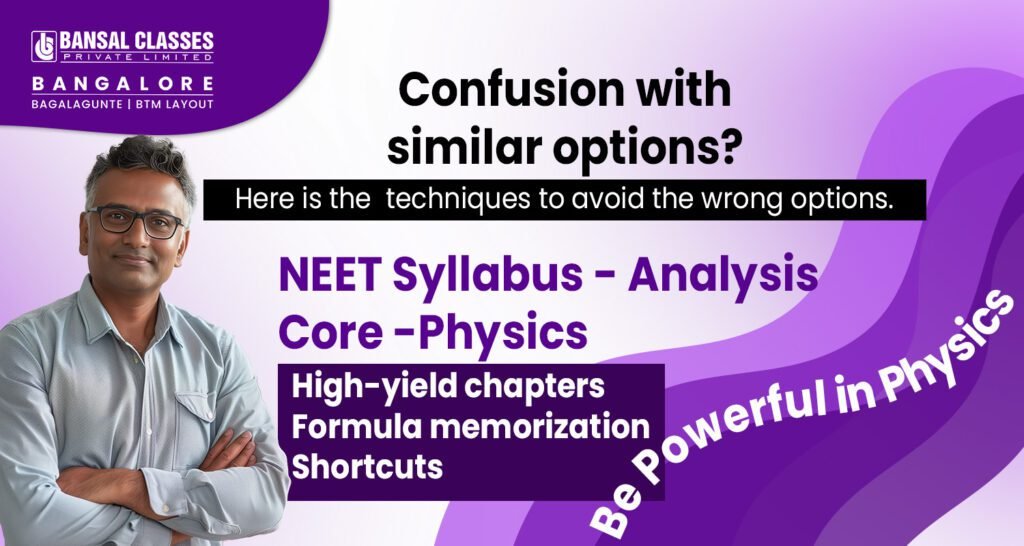
NEET Physics 2025 Mastery: Beyond Formulas
A. High-yield chapters that contributed 70% to my physics score
I’ll just come out and say it – not all physics chapters are created equal for NEET. When I was drowning in the massive syllabus, I discovered that focusing on certain chapters gave me way more bang for my buck.
Here are the high-yield chapters that literally changed my NEET Physics 2025 game:
1. Mechanics (25-30% of questions)
- Kinematics and Newton’s Laws
- Work, Energy, Power
- Rotational Motion
- Properties of Matter
- The foundation of physics. Master these, and you’ve got a solid base for everything else. I spent 40% of my physics study time here and it paid off big time.
2. Electrodynamics (20-25% of questions)
- Current Electricity
- Electromagnetic Induction
- Alternating Current
The NEET examiners LOVE these topics. Current electricity alone gave me 4-5 questions in my paper.
3. Modern Physics (15-20% of questions)
- Photoelectric Effect
- Atoms and Nuclei
- Semiconductor Devices
These chapters of NEET Physics 2025 might seem abstract, but they’re actually question goldmines. And honestly? They’re more straightforward than they look.
4. Optics (10-15% of questions)
- Ray Optics
- Wave Optics
The ray diagrams and wave calculations here show up year after year. My secret? I didn’t give equal time to all chapters . Instead, I allocated study time proportional to their weight in the exam:
Study time allocation = (Chapter’s question weight) × (Personal difficulty level 1-3)
This meant I spent much more time on Mechanics and Electrodynamics than on topics like
Let me tell you something embarrassing. Three months before NEET, I still couldn’t remember half the physics formulas.
Then I discovered visual mnemonics, and everything changed.
Here’s exactly how you can memorize 150+ physics formulas for Thermodynamics and Waves, which appear less frequently NEET Physics 2025.
:
1. Create Formula Maps
Instead of isolated formulas, I drew concept maps connecting related formulas. For example, my
“Circular Motion” map had centripetal force at the center, with all related formulas branching out like
spokes of a wheel.
2. Color-Code Formula Components
I assigned colors to different types of variables:
- Red: Force-related variables (F, p, etc.)
- Blue: Energy-related variables (W, E, P)
- Green: Time-dependent variables (v, a, t)
- Purple: Angular variables (θ, ω)
This helped my brain categorize formulas visually.
The “Formula Story” Technique
For complex formulas, I created mini-stories. For example, to remember the formula for magnetic force
(F = qvB sinθ): A charge (q) was running very fast (v) when it met a magnetic field (B). They clashed at an angle (sinθ), creating force (F).
Silly? Sure. But I never forgot that formula again.
The Dimensional Analysis Shortcut for NEET Physics 2025
When I blanked on an exam, I could often reconstruct formulas by analyzing dimensions. If I needed a formula for acceleration but couldn’t remember it, I’d think:
Acceleration is in m/s²
What combination of variables gives m/s²?
Oh right, v²/r for circular motion!
Formula Flashcards with Pictures of NEET Physics 2025
I created flashcards with the formula on one side and a visual representation on the other. For projectile motion, I drew the parabolic path with the relevant formulas positioned at different points of the
trajectory.
With these techniques, my formula recall improved from about 40% to over 95% in just a month.
C. Problem-solving shortcuts nobody teaches
The standard NEET advice for NEET Physics 2025 ? “Practice more problems.”
But nobody tells you HOW to practice efficiently. Here are my actual problem-solving shortcuts that
saved me tons of time:
The 30-Second Setup Rule
Before touching any calculations, I’d spend 30 seconds setting up the problem:
Identify the final unknown variable
List given variables
Choose the shortest formula path between them
This alone eliminated 90% of the “I don’t know where to start” panic during the exam.
The Unit Conversion Check for NEET Physics 2025
Before substituting values, I’d convert all units to SI. This simple step prevented countless calculation errors. But you do not make that in the coming battle of NEET Physics 2025.
3. The Estimation Method for NEET Physics 2025
For MCQ problems, I’d first estimate the approximate range of the answer before calculating. If the
answer should be “around 10,” and I got 0.01, I knew I’d made an error without wasting time on the full calculation.
The “Physics Trio” Method for for NEET Physics 2025
For mechanics problems, I’d always check if I could solve using any of these three approaches:
Energy conservation
Momentum conservation
Direct force analysis
Often, one approach was dramatically faster than the others.
- The Graphical Solution
Some problems that look calculation-heavy can be solved with a quick sketch. For example, in optics, a quick ray diagram often reveals the answer faster than working through formulas.
- The Limiting Case Check
I’d test my final answer by checking extreme values. If the problem asks for a car’s stopping distance and my formula gives zero distance when initial velocity is zero, I knew I was on the right track.
These shortcuts didn’t just save time—they dramatically improved my accuracy. When I had more time per question, I made fewer careless errors.
D. Common calculation errors and how to avoid them
I’ve made every calculation mistake possible in NEET physics 2025. Here are the specific errors that cost me (and could cost you) precious marks:
- Sign Convention Errors
This was my biggest nemesis, especially in:
Optics (real/virtual images)
Thermodynamics (work done by/on system)
Electrostatics (attractive/repulsive forces)
My solution: I created a single-page “Sign Convention Cheat Sheet” and reviewed it before every
practice session until it became second nature.
- Rounding Too Early
I learned this the hard way: rounding intermediate values leads to significant final errors. I started
carrying all decimal places until the final answer, then rounding to the appropriate significant figures.
- Calculator Errors
Common ones include:
Forgetting to clear previous calculations
Missing parentheses in complex expressions
Using degrees when radians are needed (or vice versa)
My fix: I developed a calculator routine—clear memory, check mode (DEG/RAD), and verify each entry before pressing equals.
- Magnitude vs. Vector Confusion
In vector problems, mixing scalar and vector quantities is disastrous. I started explicitly writing vectors with arrows (→) above them in all my work.
- Unit Consistency Failures
Mixing units (like using cm with formulas that need meters) caused countless errors. My solution was simple but effective: I converted EVERYTHING to SI units before starting calculations.
- The Equal Sign Chain
Writing calculations like 5 + 3 = 8 × 2 = 16 seems convenient but led to errors. I trained myself to write each step on a new line to maintain clarity.
- Substitution Errors
When plugging values into formulas with multiple variables, it’s easy to put numbers in the wrong places.
I developed a habit of writing the formula, then writing each variable with its value underneath before substituting: eg Newton’s Laws Of Motion
F = ma
F = ? m = 2kg a = 10m/s²
F = 2kg × 10m/s²
F = 20N
By addressing these specific error types, I improved my physics accuracy from about 65% to over 90% in practice tests—translating to about 25 extra marks in the actual exam.



